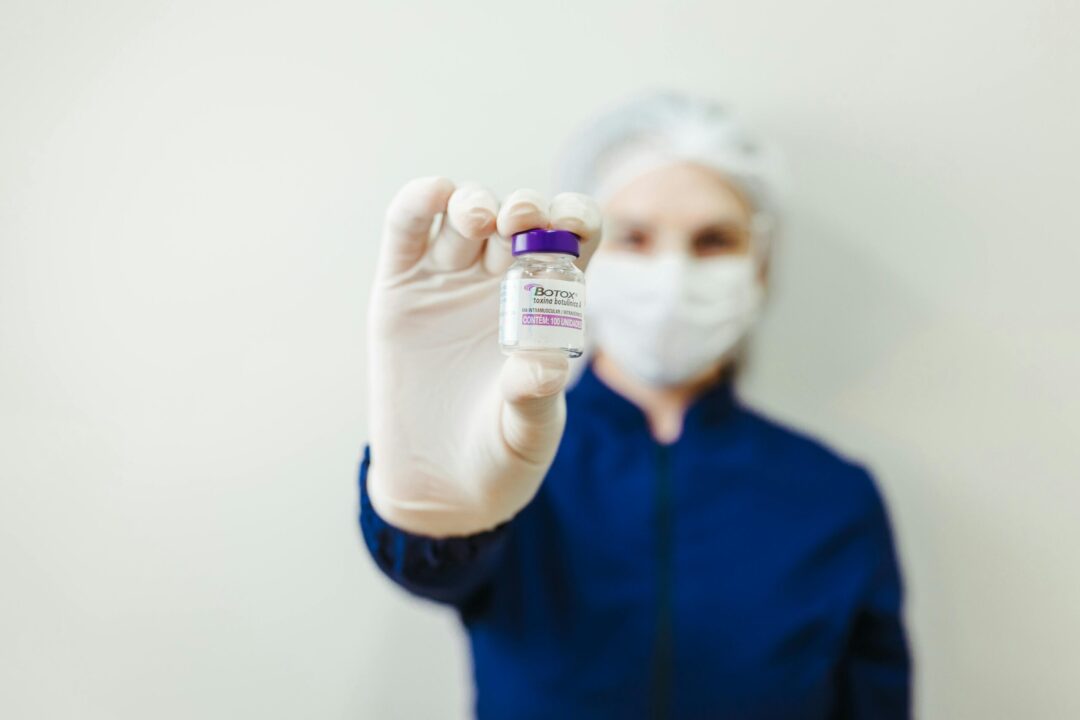Onabotulinum toxinA (commonly known by its trade name Botoxᵀᴹ) is an effective treatment for chronic migraine (when headache occurs for 15 days or more a month for at least three months).
Botoxᵀᴹ is famous for erasing unwanted facial wrinkles and its inclusion in the arsenal against chronic migraine was serendipitous. People with migraine who were having Botox injections for cosmetic reasons noticed they were also having fewer migraine attacks. Clinical trials to test out its effectiveness were done and a regime of 31–39 injections in the forehead, temples and neck were approved to treat chronic migraine, as the trials showed it did in fact reduce the pain and frequency of migraine attacks in many people.
This is a treatment that’s only recommended for chronic migraine, as it has not shown to be effective for episodic migraine (where migraine attacks occur on 14 days a month or less). For migraine prevention, it works by blocking the release of neuropeptides such as calcitonin gene-related peptide (CGRP), not through paralysing muscles.
However, this isn’t an easy treatment to access in Aotearoa New Zealand. We know from our Migraine in Aotearoa New Zealand Survey 2022 that around a third of people with chronic migraine had never used Botoxᵀᴹ but would like to try it.
Botoxᵀᴹ injections have to be repeated every three months and if you can’t get it funded through the public health system, then it costs around $1,200 per session. Technically, Botoxᵀᴹ is funded for use in the hospital setting, such as neurology outpatient departments, but practically, it’s difficult for most people to access. Hospitals may choose not to pay for Botoxᵀᴹ from their medication budget or there may not be anybody at the hospital with the capacity, ability or interest in administering it to people with chronic migraine.
We wanted to know how many people with migraine were being treated with Botoxᵀᴹ in the public health system, so we put in an Official Information Act request to Te Whatu Ora/Health New Zealand.
We asked:
- How many people received onabotulinum toxinA treatment for migraine?
- How many sessions of onabotulinum toxinA treatment for migraine were delivered?
- How much money is spent on onabotulinum toxinA treatments in total and how much is spent for the treatment of migraine?
For each question, we wanted to know the results for all of New Zealand and by hospital, to look for regional differences in access to this treatment.
However, Te Whatu Ora was unable to provide information about how much Botoxᵀᴹ was used in the treatment of migraine, as this level of detail was not available without manually going through patient files. They could give us some information about how many doses of Botoxᵀᴹ were purchased and prescribed but not how many patients received Botoxᵀᴹ, as some patients would have been prescribed multiple doses. They did not have electronic prescribing that would allow this type of analysis. Even this limited information was only made available from Te Whatu Ora Waitematā (which includes North Shore and Waitakere hospitals), Te Whatu Ora Waitaha Canterbury and Te Whatu Ora Capital, Coast, Hutt Valley and Wairarapa.
For what it’s worth, between 1 July 2022 to 30 June 2023, in Te Whatu Ora Waitematā, 670 units (100IU vials) of onabotulinum toxinA were purchased and 518 doses were prescribed. For the same time period in Te Whatu Ora Waitaha Canterbury, 1,370 units were purchased, at a cost of $640,495. Te Whatu Ora Capital, Coast, Hutt Valley and Wairarapa didn’t specify a time period but reported 1,569 vials of 100IU, plus 25 vials of 300IU and 20 of 500IU.
It’s likely that most of this Botoxᵀᴹ is used to treat conditions other than chronic migraine but we have no way of knowing for sure. Basically, Te Whatu Ora is unable to assess whether anyone with chronic migraine is able to access this effective, evidence-based treatment in the public system, let alone whether there are inequities in access.
This is another example of how a system can’t improve when it can’t or won’t measure what it is or is not doing. If Te Whatu Ora don’t measure a problem, can they then ignore it? Not if we keep telling people there is a problem. If you have chronic migraine and would like to try Botoxᵀᴹ but can’t access it, or if you are self-funding Botoxᵀᴹ treatment, you could let your local MP know about this problem. Ask them to find out why this is not given as a treatment for chronic migraine in most public hospitals, despite it being funded by Pharmac.
This is a treatment that is available in places like Australia, UK, US and Canada, covered by the public health system or private insurance. This is a treatment that has been used for many years, that is safe and has fewer side effects than many other preventive medications for migraine. There is no good explanation as to why people in New Zealand have such poor access to Botoxᵀᴹ treatment for chronic migraine.
Resources
Health experts urge DHBs to fund botox as migraine treatment (newstalkzb.co.nz)
Kępczyńska K, Domitrz I. Botulinum Toxin—A Current Place in the Treatment of Chronic Migraine and Other Primary Headaches. Toxins. 2022; 14(9):619. https://doi.org/10.3390/toxins14090619
Raciti L, Raciti G, Militi D, et al. Chronic Migraine: A Narrative Review on the Use of Botulinum Toxin with Clinical Indications and Future Directions. J. Integr. Neurosci. 2022, 21(5), 141. https://doi.org/10.31083/j.jin2105141
Photo by Jonathan Borba: https://www.pexels.com/photo/woman-holding-botox-flask-15688019/


